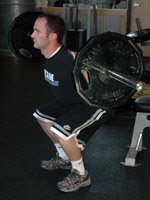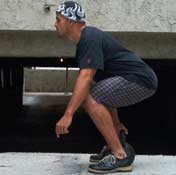Article Summary:
|
Most exercises target a select group of muscles, but there is an elite group of exercises that are full body muscle-builders. These exercises develop muscle throughout your body overall. Do these exercises, and you won't just feel them in your legs or shoulders. You will feel the anabolic effects of these exercises ripple throughout your entire physique.
20-Rep Breathing Squats
The classic bodybuilding method for gaining muscle mass is the "breathing squat." It was a method popularized by Ironman editor Peary Rader in the early days of bodybuilding, and it is the one method that consistently produces results.
People looking to produce size always come back to this method to jumpstart their gains. The popular book "Super Squats" by Randall Strossen renewed interest in the technique.
If you're not familiar with breathing squats, it's really simple in theory, BRUTAL in execution. Take a 10-15 rep max weight for the back squat (full range version) and perform 20 reps instead. What will happen is you'll get to the 10-15th rep, stand still with the bar on your back, breathe a few breathes, then do another rep, breathe a few deep breathes, then do another rep, and so on and so forth until you reach 20 reps.


 Click To Enlarge.
Click To Enlarge.
Back Squat.
Video : Windows Media
What you're essentially doing is a form of rest-pause for squats, but a better version of it. Breathing squats induce hypoxia (breathlessness). This state of oxygen debt forces your body to produce more red blood cells. More red blood cells mean more carriers of your body's major anabolic hormone: testosterone.
You'll be producing more testosterone, because of the heavy squatting. Anytime you lift heavy for an extended set, however, your body will produce growth hormone as well. 20-rep breathing squats will definitely light the anabolic blowtorch.
Snatch-Grip Deadlift
Steve Reeves performed a variation of this one where he gripped the first two plates of the barbell and performed wide grip deadlifts. But for us with short levers, we have to do the snatch-grip deadlift.
| RELATED ARTICLE | ||
|
This is a great exercise not just for the legs, but also for your lats, since they must isometrically contract to hold the weight. If you don't know how to do a lat spread bodybuilding pose, then this harsh exercise will beat the snot out of you to teach you.
Olympic lifters primarily use this version of the deadlift. The main difference between the snatch-grip deadlift and the conventional deadlift is the grip width. The snatch-grip is much wider. Your arms extend and lock out at a 45º angle to your body.
This ultra-wide grip forces you to squat down even lower than a regular deadlift, which activates your quads and glutes more than regular deadlifts.


 Click To Enlarge.
Click To Enlarge.
Regular Deadlift.
Video : Windows Media
Keep your shoulders back and your torso straight and upright throughout the entire movement. Flex your lats throughout the entire movement as well, since this will help stabilize the weight as you move.
The Kettlebell Swing
Kettlebells are an excellent training tool that provides multiple benefits:
- Greater Explosive Strength
- Greater Strength Endurance
- Fat Loss
- Greater Tendon And Ligament Strength
Bodybuilders, however, can use kettlebells to develop greater size and muscular development. Traditional kettlebell exercises (swings, snatches, clean and press, clean and jerk) stress the hamstrings and the body as a whole. What you'll find, however, is that you'll develop incredible thickness in the shoulders, trapezius, forearms, biceps and back.
Although the kettlebell snatch provides better gains in hypertrophy and explosive power, the kettlebell swing provides about 90% of those gains with minimal coordination needed. As far as cost-benefit ratio, the swing is a better choice, because the learning curve is short, and you won't be bruising your forearms.
To perform the kettlebell swing, take a natural squat stance, bend slightly at the knees and lean forward from the hips. Stick your butt out as if you're about to sit. Keep your head up and look straightforward. Keep your back flat.
From this position, reach down and grab the kettlebell. Explode up through the hips while keeping your arms straight and loose. Swing the weight up, but do not use your arms or back to swing. Keep your shoulders down and relaxed, but use your legs to drive the weight up. As you swing the kettlebell up to eye level, straighten up the torso. Lock out the hips and knees at the top position.
With each repetition, inhale at the bottom of the swing. As you explode up, breathe out and tighten your abs at the top position.
Pull-Ups
The pull-up is completely and utterly unforgiving. You either can do a pull-up, or you cannot. Your chin passes the finish line that is the bar, or you hang there helpless. That bar is a clear demarcation of manhood. Although the pull-up is not a full body exercise, its effects on upper body hypertrophy and strength are quite profound. The pull-up is the upper body's anabolic blowtorch.
To perform the pull-ups, you must start each rep from a dead hang position with straight elbows and clear the bar with your chin at the end of each rep. For those of you who have difficulty performing pull-ups, here are some pointers:
- Squeeze the bar as hard as you can. Pretend that you're trying to bend the bar around your chest.
- Stick your chest out and keep your shoulders back. This will help activate your upper back muscles.
- Look up at the bar. Where you're looking at is where your body ends up going to, so always look up and over the bar.
- Pull your elbows down towards the floor as you pull up. Driving your elbows towards the floor will help activate your lat muscles more.
- Breathe in at the bottom and breathe out as you pull up. At the top of the pull-up and at the end of your exhale, tighten your abs as hard as you can.
Ignite The Anabolic Blowtorch!
The great thing about these exercises is that not only will you develop overall strength relevant to the real world, these exercises will develop a physique that is both admired by the ladies and respected by men for its look of power.
About The Author:
James Chan is a police officer for the University of California. His newly released book Strength and Physique Volume 2: Neo-Classical Bodybuilding is available at Amazon.com. For more of his insights into strength training and bodybuilding, visit his blog at https://strengthandphysique.blogspot.com.







